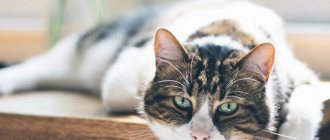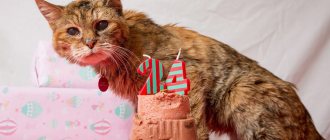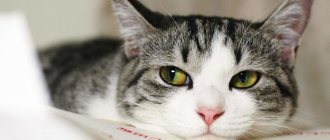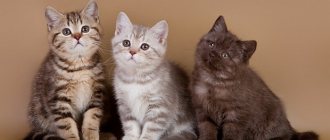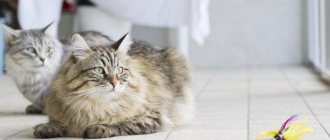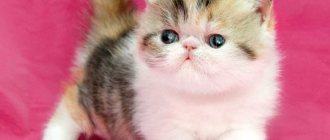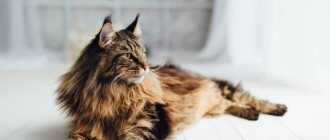British Shorthair cats are one of the most popular domestic cat breeds in the world. They are also well known for their long lifespan, with many living between 15 and 20 years . However, what factors influence life expectancy? There are several things an owner can do to ensure that their British Shorthair cat lives a healthy life and reaches its full age.
In this article, we will discuss these tips and how they can affect your cat's lifespan.
British Shorthair lifespan
The British Shorthair cat is generally a healthy animal. As stated above, the average lifespan of these cats is around 15-20 years .
Cola the cat may be the oldest known individual, reaching the staggering age of 28 years!
Of course, these numbers apply to cats that receive proper care throughout their lives. If a cat does not receive proper care, it can have a painfully shortened lifespan. Let's look at the different factors that can affect a cat's health at different stages of its life.
Treatment and vaccination
Let's start with vaccination. Opponents of this good cause are strongly recommended to watch the first episode of the first season of the famous “House M.D.” Hugh Laurie, with the cynicism characteristic of his character, clearly explains the consequences of refusing vaccinations.
A separate song about vaccinations for domestic cats. It would seem that there is nowhere for the cattle to become infected. Especially the cattle, which don’t even go to exhibitions. He stays at home and does not communicate with other cats.
Hosts or guests come from the street. On their shoes - and we remember that proletarians have not worn galoshes since 1925 - special thanks to our Bulgakov Michal Afanasyich for this - people will bring anything into the apartment. Any helminths, any sore. Guests have their own cats, dogs, and guinea pigs, which can also be hosts or intermediate carriers for various parasites, viruses, and bacteria.
Therefore, we follow the veterinarian’s recommendations and follow the vaccination schedule. It is said to inject Multifel 4 annually - that means inject. If we don’t want the cat to become infected with one of the four infections, it’s not for nothing that the number 4 is present in the name of the drug.
Now about the treatment. If your cat doesn’t eat for a day or two, it’s time to be wary. He doesn’t eat for three - let’s go to a normal veterinary clinic. We choose according to the reviews of friends, according to the recommendations of the breeders from whom we bought the kitten. Not every veterinarian will understand a cat's needs.
How can you ensure your British cat lives a long, healthy life?
Since British Shorthair cats are prone to illnesses in old age, it is important to provide them with proper care. This will ensure that your British Shorthair lives a long and healthy life.
© shutterstock
Here are some of the problems that British Shorthair cats may encounter as they grow up:
- Hypertrophic cardiomyopathy : when thick heart cells along the heart wall limit proper cardiovascular function.
- Kidney failure : due to infections, blockage or malnutrition.
- Oral squamous cell carcinoma : This deadly cancer starts in the cells of a cat's mouth and face, is difficult to detect and is very aggressive.
- Urinary tract infections : A urinary tract infection that can cause kidney infections.
To reduce the chance of your British Shorthair developing any of these conditions, it is important to start proper care at a young age and continue it into adulthood.
History of the British shorthair breed, briefly
One of the oldest cats in England is the British Shorthair and has Roman roots. To protect food supplies from rodents, Roman troops took cats with them. When the Romans invaded England, the cats colonized the area and became common street cats for centuries.
The first British breeder in the late 1800s was Briton Harrison Ware. He domesticated the British street cat and through selective crossbreeding and a breeding program created the British Shorthair cat. The first professional exhibition was held in London on July 13, 1871 at the Crystal Palace; blue color was then considered the only correct color for the British.
During World War II, the breed almost ceased to exist. To preserve their existence, the remaining bloodline cats after the war were crossed with other breeds, including domestic shorthair, Persian, and Russian Blue.
The American Cat Association was the first to register the breed in 1967. After the International Cat Association - 1979, Association of Cat Fanciers - 1980.
British Shorthair, appearance
The British are stocky, harmoniously built, broad-chested, and at shows they are judged according to the breed standard.
There are no ideal standards; breeders strive for perfection in their work.
At exhibitions you can see several types of British cats:
- The old classic - quite a lot of such animals are born, they are bought by novice lovers, and not by competent breeders. What do they look like? The animals have a slightly elongated body, close-fitting fur, high thin limbs, a narrow head with a weakly pronounced transition from an unfilled flat forehead to a long nose, narrowed to the lobe;
- Modern - squat and broad-chested, the head has smooth outlines from all angles, plush fur, a detailed description in the standard is described here.
- Extreme - characterized by an “exoticness” that is unnecessary for British cats, which leads to breathing problems, malocclusions, and excessive lacrimation due to an abnormality in the structure of the tear ducts - this is a dead end in the development of the breed.
British Longhair | British Longhair
A variety of British cat with long hair, separated into an independent breed. This breed appeared as a result of crossing a Persian and a British cat. The gene responsible for long hair is recessive, so a long-haired kitten can only be born from a pair of male and female cats carrying this gene. If one of the parents does not carry the gene for long hair, then all kittens in the litter will have short hair.
photo of british longhair
British Longhairs are also assessed according to the standard, more details here.
Characteristics: fluffy Britons, like shorthaired ones, have a massive, squat body with a large head, the main difference is their hair. It should be of medium length, smooth and very dense, with a sufficient amount of undercoat. Due to the thick undercoat, the coat is separated from the body. “Pants” and “jabot” are desirable. The tail should be thick and fluffy to highlight the beauty of the cat. The texture is quite coarse and crisp, but softer than the British Shorthair.
photos of lilac british longhair cat
The British cat is always straight-eared! Fold cannot be British, it is either a mixed breed (not purebred) or a Scottish Fold. Straight is also a type of Scottish.
Eye color corresponds to coat color: blue, yellow, copper-orange, green; whites can have different colors - heterochromia.
Coat color: color point, red, chinchilla, tabby, black, cream, blue, white, lilac, chocolate, tortoiseshell, cinnamon, bicolor.
British shorthair kittens
Most pet owners adopt their cats as kittens. The first year of a cat's life is of great importance for its overall well-being. To get your cat through adolescence and into adulthood, you must do a few things.
- Sterilization and castration . First, it is recommended to spay or neuter your cat. This will prevent medical complications and also reduce the likelihood of stray cats. Stray cats are more likely to become infected with infectious diseases and get into fights with other animals.
- Keep them out of harm's way . Secondly, always keep your British Shorthair kitten indoors only! Your kitten could get hit by a car or get poisoned; the external dangers are too great to take any chances. Additionally, you should cat-proof your home by eliminating any source of danger.
- Keep them mentally stimulated . Third, make sure your British Shorthair has plenty of things to play with and jump on. You want to make sure they don't get bored or frustrated too easily, otherwise they might take it out on your personal belongings.
- Feeding _ Feeding your cat is a major factor in the lifespan of a British Shorthair cat. You should mainly feed your pet cat food, not people food.
When to castrate a cat
British cats are recommended to be neutered after 7 months. It is advisable that he does not have matings. By this age, his genital organs and associated systems have been formed.
At a later age, castration is possible, but some cats do not stop marking or showing interest in the opposite sex.
British people should not undergo surgery if:
- During illness;
- For obesity;
- In stressful situations;
- With reduced immunity;
- In case of intolerance to anesthesia.
There is no need for castration until 6 months of age. Rarely does puberty become fully apparent before this age.
How to keep your adult British Shorthair healthy
Once your kitten is a healthy adult, keeping her healthy will be much easier. Cats are very independent and know how to take care of themselves.
You can still do your part by feeding them high quality food and giving them plenty of water to drink. If you have multiple cats, it is a good idea to provide each cat with their own litter box to avoid territorial disputes or cross-contamination that may arise.
Make sure your British Shorthair has the opportunity to climb on things from time to time! A bored cat will often find ways to entertain itself, and an inactive cat is more likely to get sick.
© shutterstock
What can you do?
Many owners who, of course, love their furry friend can help ensure a long and happy life.
If you want this, then follow some of the rules below:
- Everyone needs fresh air! Therefore, periodically walk your pet, let it out onto the veranda or balcony;
- the British need grass, vitamins and various food additives;
- active life! Play with your animal more often, give him the opportunity to run and jump, as much as he wants;
- quality nutrition should come first! For such purebred cats, be sure to buy expensive premium food.
So, let's go into more detail. In order for your kitten to have a rich and long life, he needs fresh air. His immunity will be strengthened when he can breathe fresh oxygen.
Being active is also good for the lives of animals. Therefore, owners and all household members should play with their British cat. Balls, ropes, lasers and other objects will help you with this. You can build shelves against the wall that will help your pet climb heights in your home.
Good quality fresh water and food contributes to a cat's longevity. Therefore, you should often wash and change bowls, buy fresh and high-quality products. If the owners decide to feed the British cat breed with natural food, then it is worth buying lean meat.
For their diet, chicken or beef is best suited. If the owners of a kitten want to feed it dry food, then they should buy those specifically designed for the British breed. Typically, such high-quality food comes in slightly smaller sizes than others.
And this is due to the fact that this breed has flattened and small jaws, so it is easier for them to chew small food. Or you can purchase wet food for this breed of animal.
However, remember that such food should be expensive and from a trusted company, because only such food contains vitamins, minerals and meat, which are so necessary for a healthy body.
It is also important for pets to receive various vitamins. There are many varieties of them, for example, for neutered cats, for improving coat, for strong bones and teeth, and so on.
Therefore, you can consult with a specialist at a pet store or with an experienced veterinarian to choose the best and necessary for your kittens.
By following the above guidelines and taking good care of your British cat, you can help him live a long and happy life!
How to care for an older cat
When your cat reaches 11-15 years of age, she will be considered a geriatric or senior cat. As with people, health problems may begin around this time.
- Diet and exercise
It is important to ensure that they have a healthy diet so that their kidneys and liver can continue to function normally. You also need to be careful with the treats you give them, as too many calories can lead to weight problems since they don't exercise as much.
With their weakened bodies, older cats may also need walking. Walking your cat may seem strange, but it can be beneficial for them. They may not want to get up and move around on their own, so you should do this at least once or twice a day.
- Monitor your symptoms
During this period, it is more important than ever to monitor any changes in their behavior, appetite and toileting habits. Some clues that your senior cat may need some extra help include: sleeping for long periods of time, not grooming enough, using the litter box incorrectly, or sudden weight gain.
The most important thing to do is talk to your veterinarian about any changes in your cat's behavior.
Skin diseases
There is a fairly extensive list of skin diseases in cats. These include scabies and dermatomycosis. Fleas, mosquitoes and ticks, allergies are often the cause of eosinophilic granuloma. Hair lice and other parasites cause great suffering to furbabies.
Skin diseases of the British cat
The pet's belly hangs
The formation of a small skin fold in a British person may be normal. Scientifically, this fold is called the fat tail. It is worth observing the behavior of your pet. If he is active and has a good appetite, then there is no reason to worry. But if a hanging belly is associated with obesity, then it is worth reviewing the diet and putting the cat on a diet. If you have no appetite, you should be concerned and contact your veterinarian. The reasons for this phenomenon may be different.
Common health problems in British cats
Cats suffer from a variety of minor illnesses that do not pose a real threat to shortening their lifespan. However, some diseases or conditions are more serious. The most common diseases of British Shorthair cats are arthritis, kidney disease and diabetes. These diseases can be prevented with regular veterinary examinations and careful pet care.
Other factors that can affect a cat's lifespan include dental problems, which can lead to malnutrition or brain damage from an accident (such as a fall).
An overweight British Shorthair cat is also at risk of developing arthritis or diabetes as they age. A pet owner should ensure that their cat does not become overweight by monitoring her weight using a scale and feeding her accordingly.
Article by: Oliver Jones Oliver (Ollie) Jones is a zoologist and freelance writer living in South Australia with his wife Alex, their dog Pepper and their cat Steve. Originally from the USA, Ollie has a Master's degree in Wildlife Biology and moved to Australia to pursue his career and passion, but has found a new love for working online and writing about animals of all types.
Famous British centenarians
Many representatives of this breed have claimed the title of long-liver:
- The owners of the British cat Muskatik, who was approximately 31 years old, applied to the book of records. But the problem was that the animal was found on the street in 1990 and the veterinarian determined that the cat was 5 years old at that time. Now the owners are proving the truth of this statement and are trying to legitimize the national longevity record.
- The same fate befell the famous Lucy from South Wales, who lived for 43 years. Picky experts doubted the authenticity of the cat documents and did not perpetuate the memory of this animal.
The lifespan of British cats must be divided into two unequal parts. The first includes early childhood and reaching puberty.
If at this time the animal is fed well and is under the constant supervision of a veterinarian, then the second half of life (maturity and old age) will pass quietly and will not end soon.
Maximum attention and love for the furry pet is all that is needed for the cat to live next to its owner for as long as possible.
Factors that influence the age of a pet
This breed is very beautiful and such pets, as a rule, are kept to participate in various competitions or to breed new offspring. Such pets do not survive on the street, as they are gentle and very domestic creatures . British cats live best at home and with proper care.
The following factors influence how long British cats live:
- genetic predisposition to certain diseases;
- living conditions of a cat;
- food;
- the presence of stress.
The British have a well-developed immune system by nature, but nevertheless, they are susceptible to some diseases. Diseases can be transmitted from other felines or even from people.
Living on the street significantly shortens an animal's lifespan. It is also reduced by stress, infections, cat fights and bad food. Oncological diseases are not typical for this breed.
